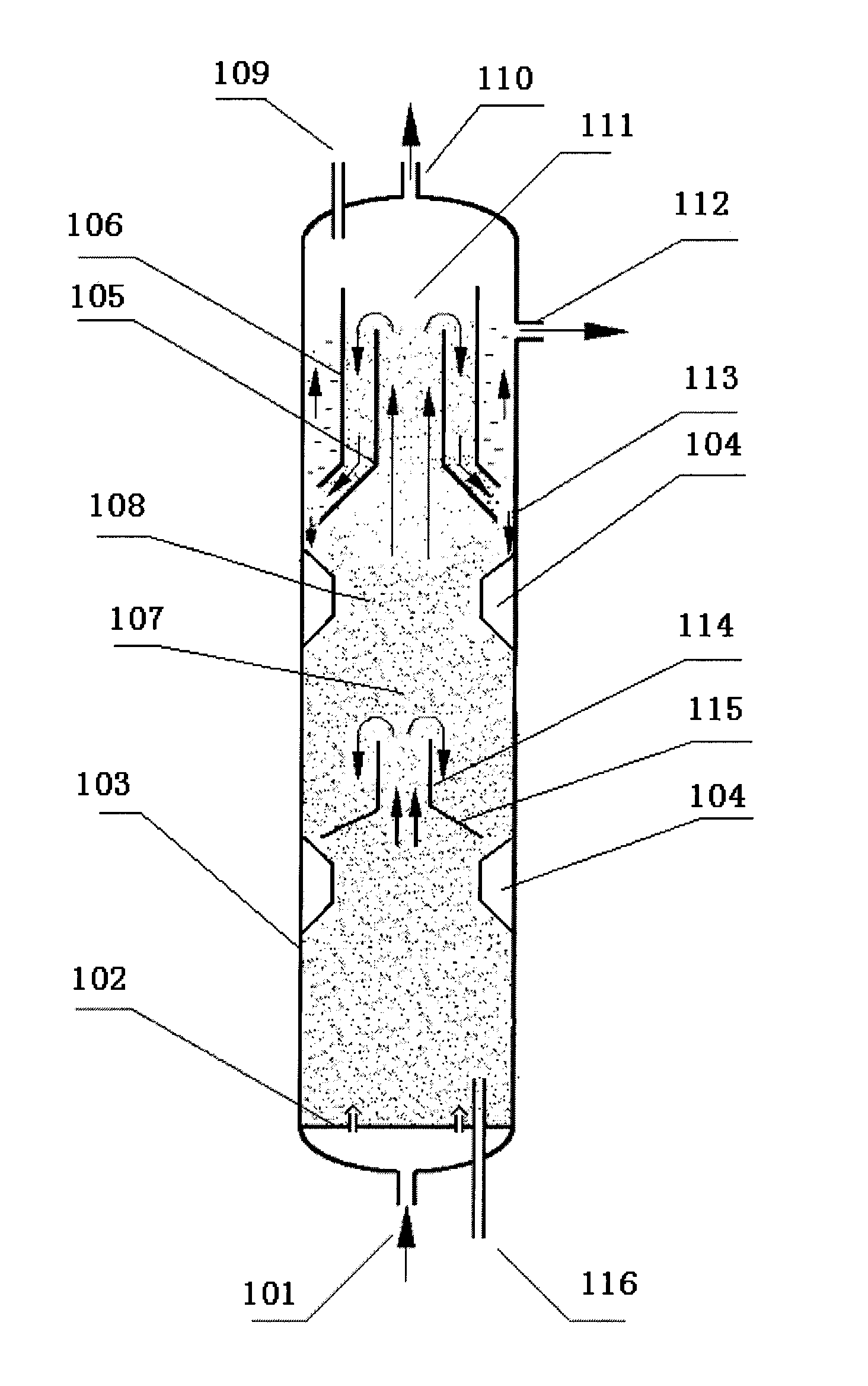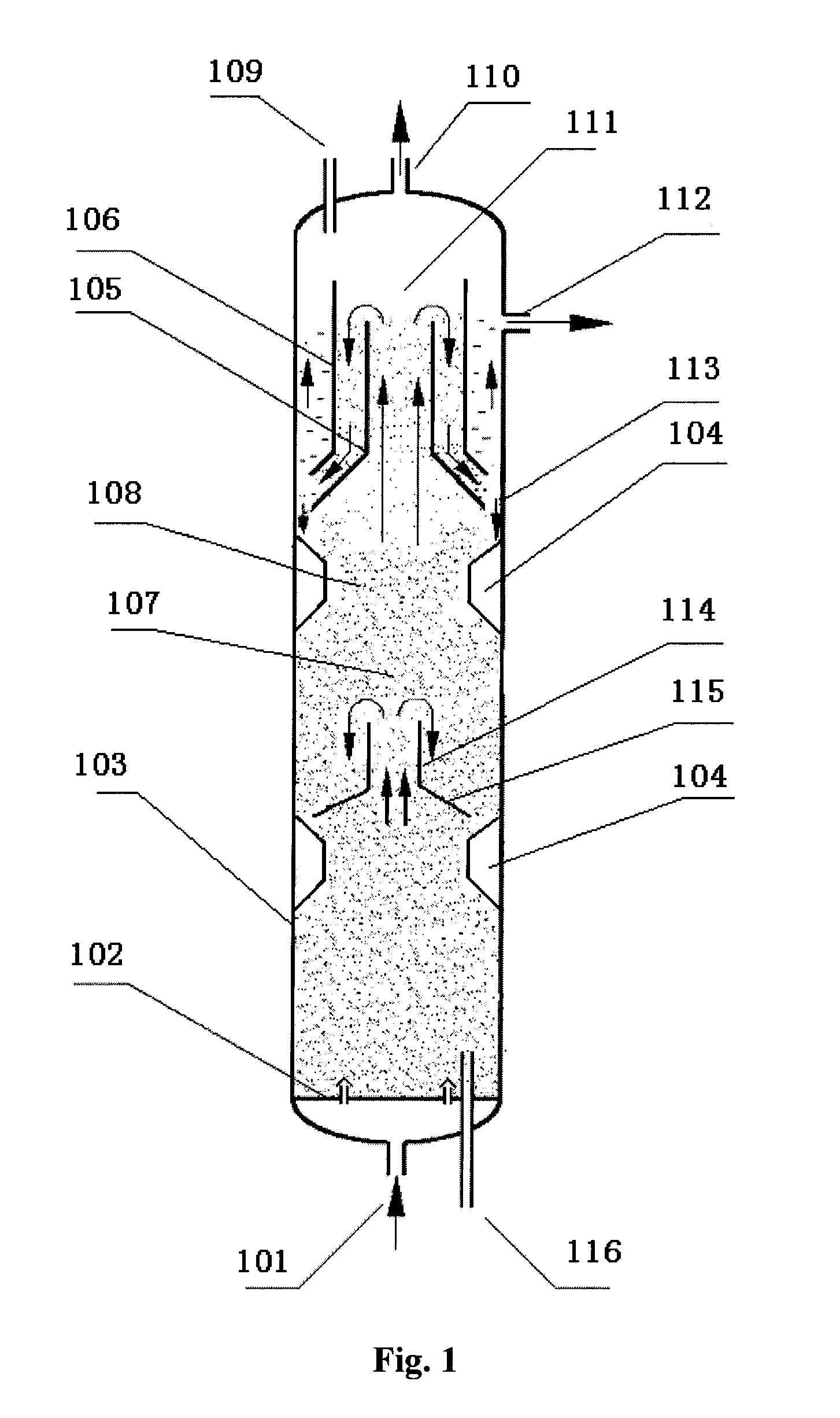Fluidized-bed reactor and hydrotreating method thereof
a technology of fluidized bed and reactor, which is applied in the field of reactors to achieve the effects of enhancing conversion ratio, prolonging residence time, and improving yield of light oil
- Summary
- Abstract
- Description
- Claims
- Application Information
AI Technical Summary
Benefits of technology
Problems solved by technology
Method used
Image
Examples
example 1
[0063]The residual oil used in the test has properties as listed in Table 1. From Table 1 it can be seen that the carbon residue content in the residual oil is 13.6 wt %, metal content is 141.9 μg·g−1, bitumen content is 6.4 wt %, sulphur content is 2.5 wt %, and nitrogen content is 0.6 wt %.
[0064]The microspheric catalyst used in the test has an average diameter of 0.6 mm, a pore volume of 0.60 mL / g and a specific surface area of 140 m2 / g, with alumina oxide as the carrier. The pore volume less than 8 nm amounts to 2.6% of the total pore volume, and the pore volume of 15˜30 nm amounts to 65% thereof. The catalyst contains 11.2 wt % of MoO3, 3.0 wt % of NiO and 1.4 wt % of P.
[0065]The test adopts a conventional fluidized bed hydrogenation process, with the fluidized bed reactor including one inner circulation zone as shown in FIG. 1.
[0066]There is one circulation zone in the fluidized bed reactor, and the fluidized bed reactor is sized as follows: the inner size of the reactor shell...
example 2
[0070]This Example relates to a hydrogenation method with the fluidized bed reactor according to the present invention. The operation process is as shown in FIG. 2, and there is one inner circulation zone arranged in the fluidized bed reactor.
[0071]The process is as follows. Heavy hydrocarbon-containing raw material 6, after being blended with hydrogen 5, enters into the fluidized bed reactor 7 in an upflow manner and is contacted and reacted with the catalyst. After hydrogenated in the fluidized bed, the flow is discharged from the top of the reactor and enters into the high pressure separating device 8 for gas-liquid separation. The liquid-phase resultant amounting to 15 wt % of the reacted liquid-phase flow is blended with hydrogen 4, and upflows into the expanded bed reactor 3 for further hydrogenation reaction. The reacted resultant is discharged from the upper part of the reactor into the high pressure separating device 8. The gas flow separated from the high pressure separati...
example 3
[0073]The process of Example 3 is the same as that of Example 2, and the basic structure of the fluidized bed reactor is the same as that of Example 1, except that there are two circulation zones in the fluidized bed reactor of Example 3.
PUM
| Property | Measurement | Unit |
|---|---|---|
| friction angle | aaaaa | aaaaa |
| cone vertex angle | aaaaa | aaaaa |
| temperature | aaaaa | aaaaa |
Abstract
Description
Claims
Application Information
 Login to View More
Login to View More - R&D
- Intellectual Property
- Life Sciences
- Materials
- Tech Scout
- Unparalleled Data Quality
- Higher Quality Content
- 60% Fewer Hallucinations
Browse by: Latest US Patents, China's latest patents, Technical Efficacy Thesaurus, Application Domain, Technology Topic, Popular Technical Reports.
© 2025 PatSnap. All rights reserved.Legal|Privacy policy|Modern Slavery Act Transparency Statement|Sitemap|About US| Contact US: help@patsnap.com



